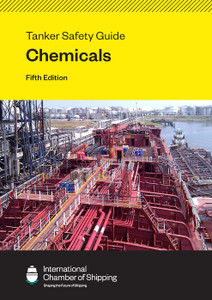
This publication explores the stages of a tanker voyage from the initial due diligence process when chartering a tanker, through to arrival and pre-transfer formalities, cargo operations and emergency preparedness. It provides terminal operators, Port Authorities, and tanker crews with a general understanding of each party’s operation and their responsibilities.
This book provides detailed guidance covering every stage of a ship’s visit to a tanker jetty. Topics covered include:
- Tanker, port and terminal equipment and regulations
- arrival and prearrival operations
- cargo management (including for specialised cargoes)
- survey and sampling procedures
- emergency response
- pollution prevention.
This revised edition is aimed at both new entrants to the industry and experienced personnel aiming to refresh their knowledge. It condenses the latest industry best practice into one comprehensive publication that is a valuable addition to any jetty office, tanker cargo control room or college library.
The ship/shore interface can be considered the most critical part of cargo and bunkering operations. The tanker and the terminal may be unfamiliar with each other’s equipment, procedures and personnel, yet within a short period of time they must work together to ensure the safe transfer of dangerous cargoes.
This publication seeks to provide terminal operators, Port Authorities and tanker crews with a general understanding of each party’s operation and their responsibilities. It explores the stages of a tanker voyage from the initial due diligence process when chartering a tanker, through to arrival and pre-transfer formalities, cargo operations and emergency preparedness. Throughout this voyage, every check and agreement mentioned in the ISGOTT Ship Shore Safety Checklist (SSSCL) is explored to provide the reader with an overview of the accountability and responsibility the terminal and tanker accept when completing the checklist.
This revised edition is aimed at both new entrants to the industry and experienced personnel aiming to refresh their knowledge. It condenses the latest industry best practice available at the time of publication into an easy reference publication that is a valuable addition to any jetty office, tanker cargo control room or college library.
Contents:
Foreword
Introduction
1. Tanker
1.1 Industry Regulation
1.2 Crewing Arrangements
1.3 Tonnage and Dimensions
1.4 Tanker Types
1.5 Tanker Design Features
1.6 Cargo Transfer Equitment
1.7 Cargo Manifold
1.8 Cargo Pump Rooms and Compressor Rooms
2. Port and Terminal
2.1 Terminal Information Booklet
2.2 Safety Data Sheets (SDS) Jetty
2.3 Design Considerations
2.4 Hazardous Areas
2.5 Marine Loading Arms (MLA)
2.6 Cargo Transfer Hoses
2.7 Cargo Transfer Infrastructure
2.8 Vapour Return Systems
2.9 Ship and Port Secruity
3. Pre-arrival
3.1 Tanker Selection
3.2 Charter Party Agreements
3.3 Ship Vetting
3.4 Port Clearence
3.5 Pre-arrival Information Exchange
3.6 Pre-operations Preparation - Tanker
3.7 Terminal Pre-operations
3.8 Notice of Readiness (NOR) and Laytime
4. Arrival
4.1 Pilotage
4.2 Tugs
4.3 Berthing
4.4 Fenders
4.5 Moorings
4.6 Safe Access
5. Pre-operations
5.1 Pre-Transfer Conference (PTC)
5.2 The Ship/Shore Safety Checklist (SSSCL)
5.3 Restricting Sources of Ignition
5.4 Communications
6. Cargo
6.1 Loading
6.2 Discharge
6.3 Ballast Operations
6.4 Inert Gas
6.5 Crude Oil Washing (COW)
6.6 Tank Cleaning (other than COW)
6.7 Purging
6.8 Gas Freeing
6.9 Tank Vetting
7. Specialised Cargo Operations
7.1 Chemical Tankers Liquefied
7.2 Gases
7.3 Cargoes Containing Hydrogen Sulphide (H2S)
7.4 Static Accumulating Cargoes
7.5 Examples of Cargo Hazards
8. Simultaneous
8.1 Maintenance
8.2 Inspection and Survey
8.3 Drills
8.4 Waste Disposal
8.5 Slops Disposal
8.6 Bunkering
8.7 Entry into Enclosed Spaces
9. Post-cargo
9.1 Bill of Lading (B/L)
9.2 Cargo Measurement
9.3 Custody Transfer Measurement System (CTMS) for LNG Carriers
9.4 Cargo Sampling
9.5 Note of Protest (NoP)
9.6 Statement of Facts
9.7 Terminal Feedback
10. Emergency
10.1 Shipboard Fire-Fighting Equitment and Procedures
10.2 Terminal Emergency Response and Procedures
10.3 Shipboard Pollution Procedures
10.4 Terminal Pollution Procedures
- Number of Pages:
- 0
- Book Height:
- 297 mm
- Book Width:
- 210 mm
- Weight:
- 1.7 kg
- Author:
Capt. Duncan Bruce AFNI
- Published Date:
- January 2022
- Preview:
- Yes
- ISBN:
- 9781914992308
- Publication Date:
- January 2022






